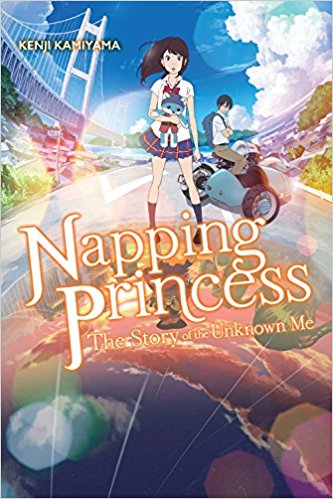By Genji Kamiyama. Released in Japan as “Hirunehime ~ Shiranai Watashi no Monogatari ~” by Kadokawa Shoten. Released in North America by Yen On. Translated by Yota Okutani.
We’ve been getting a lot of these sorts of books lately, the novelization of a popular animated film. Well, for some definition of popular – your name sort of hovers above everything else. But we’ve also gotten The Boy and the Beast, and we’re getting Fireworks: Long Title Here in the summer. And now we have Napping Princess, a book that adapts the film of the same name that came out in 2017. It’s a quick, breezy read with a likeable lead heroine and a few very interesting plot twists about two-thirds of the way through. It does, however, suffer from a problem that I really didn’t notice with the other books of this type. This sort of book is meant to enhance or add to the experience for those who saw the movie, and also make those who haven’t seen the movie want to see it. The problem is that after finishing Napping Princess, I’m left with the opinion that the movie is probably better. Which is an issue given I’ve never seen the movie.
The book starts out as a fairy tale, set in a magical kingdom that builds cars. There’s a wishy-washy king, an evil Grand Vizier, and a princess locked in a tower who can do magic. In fact, that’s why she’s locked in the tower. On the other side of things, we’re also in slightly futuristic Japan, where our heroine is Kokone, who lives with her mechanic dad in the middle of nowhere and gets by on imagination and pluck. She also likes to sleep, and dreams that she’s the princess from the fantasy kingdom. These two worlds start interacting together when her father is arrested, supposedly for data theft from Japan’s largest car manufacturer, which her dad worked for years ago. Is this all a setup? What does it have to do with her late mother? And why is it that Kokone has this magical ability to mesh the fantasy world and the real world when she dreams?
To be fair, we never get a good answer to that last question. “Magical realism” is what we’re supposed to think, I suspect. As I said, the plot is fairly straightforward, being a chase sequence for an extended stretch. Our villain ends up being so lame that the author has to put in a narrative jibe noting how much of a cliched villain he’s become – I was expecting to see some sort of story about how he and Kokone’s dad used to be friends back in the day, but no, he doesn’t even get that. The most interesting part of the book was the way the fantasy world overlaid on the real one, as both Kokone and the reader realize about the same time that the casting is somewhat different than expected. (The reader may pick this up a bit earlier, frankly, as the romantic tendencies between the princess and Peach (yes, it’s lampshaded) make little sense if Kokone is the princess.) As with most dead moms in anime, I wish we’d seen more of Kokone’s mother.
As a novelization, this book works very well. Every time it had a major set piece, I kept thinking “I’d like to see this animated”. As a novel, though, I’m not sure it works as well. Still, it’s not actually bad – just slight. It would make a good summer beach read.

